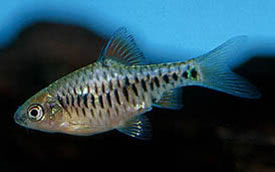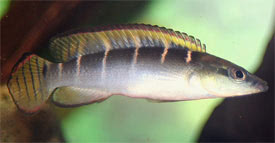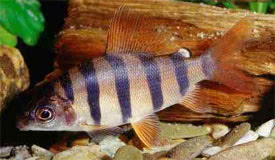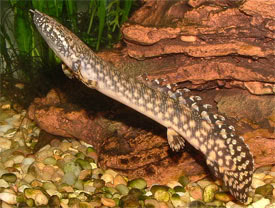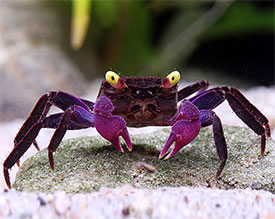
 Magyarul / Hungarian
Magyarul / Hungarian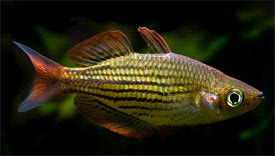
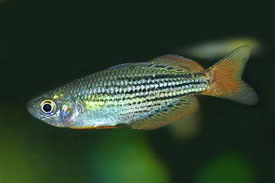

- Scientific name: Melanotaenia maccullochi
- Synonyms: Nematocentris maccullochi
- Common name: Dwarf rainbowfish, Black-lined Rainbowfish
- Group: Rainbowfish
- Habitat: Australia, Southern Papua New Guinea
- Size: 7 cm
- Biotope: Slow flowing rivers with vegetation mixed with open areas.
- Social behavior: A lively, peaceful, schooling fish
- Diet: Carnivorous; all types of live foods. Will also take flake foods.
- Breeding: Quite easy
- Tank: Minimum 80 litres
- Population: 5-6 fish for 100 litres
- Decoration: Recommended a tank moderately planted along the edges and back with fine-leaved varieties and plenty of open swimming space in the front. Use a fine gravel bottom and place the tank where it can catch the morning sun. Provide good filtration with a gentile current.
- Temperature: 22-28°C
- pH: 5,5-7,5
- Hardness: 8-18NK°
- Lifespan: 3-5 years
Description: An elongated and laterally compressed fish with a small head and a large eye. It has two Dorsal fins, the first being small and the second one is set back on the top of the body. Males are more brightly colored with sharply extended dorsal and anal fins. The male is silver with a blue iridescence. The flanks are marked with seven lateral stripes. These are yellow becoming red near at the caudal penuncle. The gill cover is marked with an orange-red spot. The fins have a greenish base with blood red outer parts. The colors of the females are less intense. Not a stunning fish, but the more you look at it the more beautiful it becomes.
For breeding use medium to hard water, from 10 °dGH at a temperature between 24-26°C. The fish are sexually mature when about one inch in size. The fish will spawn among the plants in the morning leaving behind 150 to 200 eggs, all suspended by short threads. At home Java moss or spawning mops can be used. These will hatch in seven days at 25 °C. If fed well the parents will not touch the eggs. Needs frequent partial water changes. The eggs are sensitive to light.










